|
RELATIVE
IMPORTANCE OF POCS OIL
PLATFORMS ON THE POPULATION DYNAMICS OF TWO REEF FISHES IN THE
EASTERN SANTA BARBARA CHANNEL
Principal Investigators:
Hunter Lenihan
and
Andrew Brooks
Overview
As part of our research, we have complete
laboratory and field preparations, to design and conduct fish
population surveys at POCS Platform Gina and three reference sites
on Santa Cruz Island, to tag and recapture fishes at each site
over multiple months, to estimate egg production during the late
winter-spring nesting season, and to measure recruitment in late
spring-early summer. This work covers a large proportion of the
field component of our study, although we are in the process of
finishing recruitment sampling, conducting a final population
survey, and designing and deploying a prey tethering study that
will estimate site specific predation rates on our model fish,
Coryphopterus nicholsii (blackeye goby). Data will
provide the information necessary to model population and
source-sink dynamics of our model species at POCS oil platform
Gina and three natural rocky reefs in the Santa Barbara Channel.
Population abundance
We completed population surveys at all sites to provide a time
series of population abundance of our model species,
Coryphopterus nicholsii (blackeye goby). Our surveys were
conducted in 2003 (June, July, August, and December) and 2004
(January and June). Data from surveys conducted in June and July
2003 indicate that population abundance varied among sites (Figure
1). We are currently conducting our final population survey at
all sites. Coupled with our tagging studies, our population
censuses of gobies provide information on immigration, emigration,
and mortality rates.
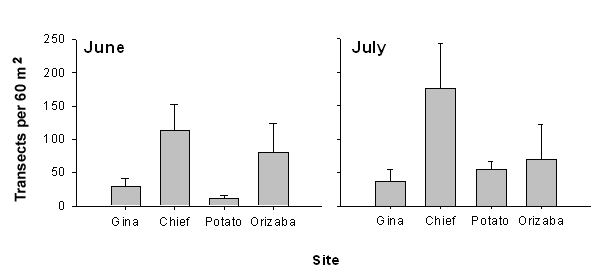
Figure 1: Results of population censes of C.
nocholsii at POCS Gina and three reference sites on Santa Cruz
Island (Chief Reef, Potato Rock, Orizaba). Error bars are
95% confidence intervals.
Per capita growth and survival
We decided to focus our tagging/recapturing effort on C.
nicholsii, the blackeye goby, due to its high abundance across
all sites and the feasability of sampling. Fish were tagged,
released and re-censused to estimate per capita survival and
growth. We completed four months of tagging (September, October,
November, and January) in which 1656 C. nicholsii were
tagged (Figure 2A) and 673 were
subsequently recaptured (Figure 2B). This 40.6% recovery rate is
extremely high and will allow for an accurate and precise estimate
of population source-sink dynamics.
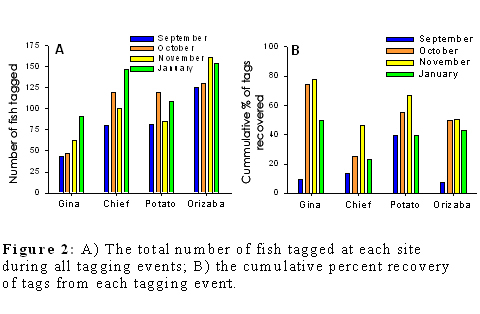
Reproductive output
To estimate reproductive output, we
collected and enumerated egg masses from POCS Gina (n = 15 egg
masses) and the three Santa Cruz Island sites (n = 11 egg masses
at each site) in late Winter-Spring 2004 (Figure 3). Eggs were
first noticed in April and some males were still guarding nests in
June. We found eggs to be very difficult to maintain alive in the
laboratory, probably because males were not present to keep water
circulating over the eggs and/or provide them with some
developmentally essential chemical signal/cue.
Figure 3:
Mean number of eggs
per clutch for egg masses of C. nicholsii,
which were collected from POCS Gina and the
three reference sites on Santa Cruz Island. Error
Bars are 95% confidence intervals. Note that the Potato
Rock site was divided into a deep and midwater sampling
scheme. For all Santa Cruz Island sites n =
11, including both depths at Potato Rock (total n
at Potato Rock = 22). At Gina n = 15.
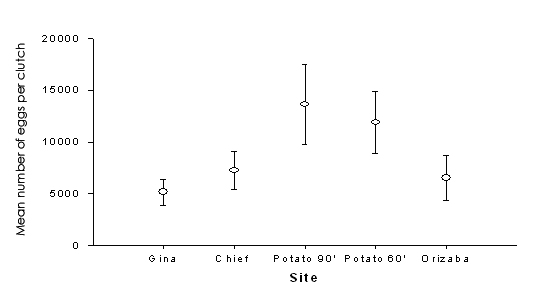
Recruitment
The recruitment of blackeye gobies was
estimated at POCS Gina, and our three reference sites in
March-July 2004. Recruits were quantified by divers who counted
the total number of YOY recruits (fishes <1 cm in length) over
four replicate 20 m x 2 m transects (40 m2) at each
site. We found very few recruits in March – May, but we found an
increasing trend in recruitment in June (Figure 4). We will also
quantify recruitment in July and August because recruitment
appears, at least this year, to be protracted over a substantially
long period.
Figure 4: Recruitment
at POCS Gina and three reference sites on Santa Cruz
Island. Error bars are 95% confidence intervals.
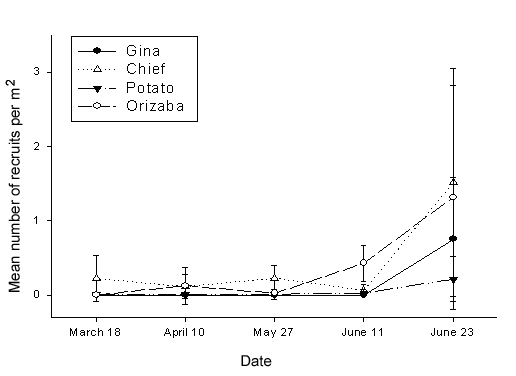
Biotic interactions
The rate of predation on
Coryphoterus by other fishes was be estimated in July and
August 2004 by tethering gobies at each site and examining their
survival over 24 hr periods. Gobies were tethered at different
depths and in different microhabitats, features that distinguish POCS platforms and natural reefs in our study, to determine how
these factors influence their survival.
Age and Growth, Connectivity
We collected otoliths from fishes at
each site and are in the process of determining ages for fishes
across a varied size range (Figure 5).
Figure 5: Length
– Weight relationship for all specimens collected
for otolith removal.
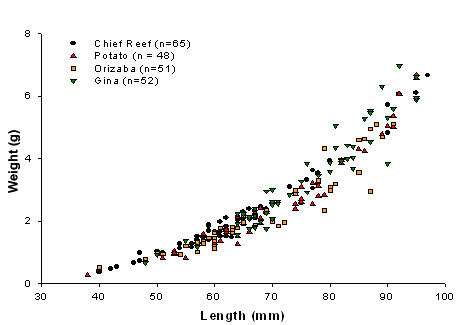
These data will provide the first age
and growth characterization for this species. In addition, we are
working with the Gaines and Warner laboratories, and the PISCO
program at UCSB to identify micro-chemistry signatures from
platform Gina and our natural reefs. These data will potentially
provide information regarding the origin of individuals within
populations at each site. This study will examine whether goby
populations are well-mixed within the Santa Barbara Channel, or,
in contrast, whether there is a degree of self-seeding on these
spatially separated locations.
Educational opportunities
We involved six graduate and nine
undergraduate students in our research during the fiscal year. We
also had six staff personnel volunteer their time on our project.
Our study overlapped with dissertation research being conducted by
graduate student Stu Levenbach of the Department of Ecology,
Evolution, and Marine Biology at UCSB. He was able to access his
sampling sites and was provided a buddy diver to conduct his
sampling and experiments in exchange for help with our sampling
and tagging studies.
|
[homepage]
|
[overview]
|
[researchers]
| [students
& staff]
|
[research] | [download reports]
|
|

